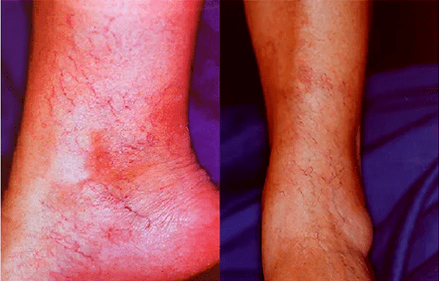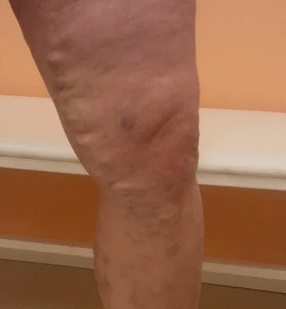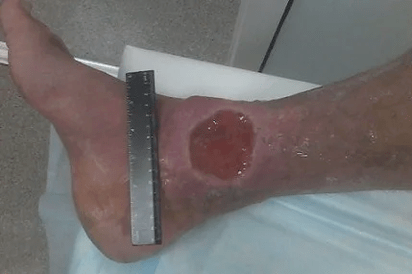
Varicose veins - This is the expansion of subcutaneous veins with a diameter of more than 3 mm.Varicose veins are developed due to the deteriorated operation of venous valves and the weakness of the venous wall;At the same time, blood exit from the lower extremities, there is an increase in pressure inside the vein, which can cause chronic venous insufficiency.
Sometimes, telanggiectasia and reticular veins are confused with open varicity.
These are veins with diameter 3 mm and lessThey do not affect the venous output flow, but cause a clear cosmetic defect.
What is the prevalence of varicose veins?
The varicose expansion of the subcutaneous veins is present in 30 % of women and in 15 % of mature age.The prevalence of varicose veins of the lower extremities increases significantly with age and is present in most people over 60 years.The proportion of patients with trophic disorders in adulthood is only 1.8%, while in old age the indicator reaches 20%.At the same time, each fifth patient in life faces thrombophlebitis.Among the reasons that lead to disability, the proportion of disabled forms of vein veins is more than arteries.
The main risk factors for the development of varicose veins are:
- elderly age
- Female gender
- pregnancy
- Hormonal disorders
- Positive family history
Additional risk factors:
- smoking
- Arterial hypertension
- constipation
Additional risk factors literature is contradictory.In addition, the risk of developing venous diseases is low.
How do varicose veins manifest?

The most frequent manifestation is the expansion veins in an unequal way that stands out on the surface.In some cases, they can hardly be notable or determined only by touch, in others they take a sinuous form with the formation of nodes or apparently resemble a large grape group.
Often, varicose veins are accompanied by the following symptoms:
- Feeling and leg tension
- Pain throwing and/or hurting the veins
- Fast leg fatigue
- Headfish of the legs of the legs
The rarely varicose disease can cause restless leg syndrome and night leg cramps.
What are the dangers of the progression of varicose veins?
In the absence of treatment, the progression of varicose veins can lead to chronic venous insufficiency (CVN).The presence of HVN indicates serious violations of the lymphatic venous performance (clinical classes C3-C6 CAEP), which include: chronic edema (lymphedem), skin color change (hyperpigmentation), venous eczema, skin compaction, trophic venous ulcer.
What are the complications of the varicose veins?
Thrombophlebitis: The formation of a thrombus in a surface venous system is an event that faces 20% of patients with varicose veins.This thrombosis is accompanied by severe pain, redness of the skin, sealing along the vein at the bottom of the leg and/or thigh.In the absence of treatment, thrombotic masses can be extended to a deep venous system.

Deep vein thrombosis (TGV) - In most cases, the beginning of the process is asymptomatic.When the thrombosis extends to the femoral segment and the vein of the pelvis, the main exit of the blood of the lower extremities is altered, which is accompanied by a severe syndrome of edema and pain and is considered a situation that threatens life.
Thromboembolism of pulmonary arteries (fabric) - In 10% of cases, thrombotic masses in deep veins of the lower extremities are fragmented and migrate to pulmonary arteries with a blood flow, causing deaths.
What is needed for the correct diagnosis?
Given the variety of forms of diseases of the veins, every detail of the history of the development of the disease and the life of the patient, the presence of concomitant diseases, the transactions, the result of an external examination by a doctor and the most important thing is ultrasound, ultrasound, the ultrasound dulctic exploration of the veins, it is important to make a correct diagnosis.The latter, today, is the most informative precise and non -invasive method to study the veins of the lower extremities.
Treatment of varicose veins, the most common methods:
- Medications for the treatment of pharmacological treatment have demonstrated their effectiveness to reduce the symptoms of varicose veins, but cannot eliminate varicose veins on their own.Pharmacotherapy is used successfully to prevent complications in risk groups, preoperative preparation and postoperative rehabilitation.
- Compression treatment - Wear special medical clothes in golf form, stockings, stockings.In some cases, multiple layer bandages with elastic bandages of various extensions and compression of hardware pneumists are used.The role of compression treatment is difficult to overestimate, is present at almost all stages of the prevention and treatment of chronic veins.
- Introduction to the light of the veins of drugs that can cause its closure.This method is a gold standard to remove reticular veins.It is used successfully in the treatment of varicose veins of not a large diameter and has restrictions to eliminate the pathological blood flow of the main subcutaneous veins.
- Classical operation - Combined phlebectomy, in modern performance, is performed in an outpatient way under spinal or local anesthesia.In some cases, this is the only feasible form when the target veins are very convincing and/or have high extensions.However, the method is lower than endo vascular traumatic procedures.
- Venous laser prison endo - A method to treat varicose veins, in which the vein is not eliminated, but closes from the inside with the energy of the laser radiation, which is taken directly to the container of the wholesale with a fiber.The effectiveness of the procedure is comparable to the results of the surgical elimination of the vein, at the same time, it is characterized by a minimum trauma.The rehabilitation time is 1-3 days.
- Radiofrequency prison - A progressive way to eliminate the pathological blood flow of the subcutaneous veins of the trunk.This is a completely outpatient procedure carried out under local anesthesia.The effectiveness of the treatment corresponds to the level of classical phlebectomy, pain syndrome is minimal or absent.The rehabilitation time is 1-2 days.












































